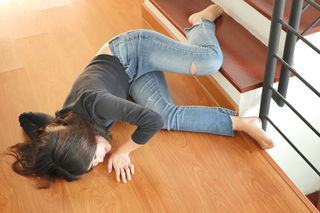Sleep
My Personal Guide to Fainting Spells
Why it happens, how it feels and what I’ve learned from passing out.
Posted May 19, 2018

The first time I lost consciousness was, conveniently, at a medical center. I was stationed in the delivery room at the right side of the hospital bed where my mother was in the final throes of childbirth. The doctor had to perform an episiotomy at the last minute (which I will not describe here, but those who are not squeamish can easily look up the details), and the resulting pool of blood on the floor was far too much for my 11-year-old self. As my sister came into the world, I felt a rush of heat followed by dizzyness, and recall myself slowly collapsing onto the floor. I was out for only a few seconds.
This type of fainting spell, I later learned, is called vasovagal syncope. Here’s how it works: the vagus nerve is the longest in the human body and, in an article last December in Medical News Today, referred to as “the most complex of the 12 pairs of cranial nerves that emanate from the brain.” The vagus nerve performs a bit like a control unit in a computer processor: it communicates information and doles out functionality between the brain, throat, heart, lungs and abdomen, in addition to a host of other responsibilities I’d need a medical degree to fully explain. It’s no wonder, then, that when one of these tasks becomes overwhelming due to an extreme emotional trigger (e.g. intense fear, traumatic shock or—the most classic case—the sight of blood), the vagus nerve instructs the parasympathetic nervous system to slow the heart rate to the point where blood stops pumping fast enough to get to the brain and a person often loses consciousness, like I did in the delivery room. Essentially, the body does what a computer does when the C.P.U. is overtaxed; it freezes, the system gets rebooted and then returns to normal soon after.
A decade later, I fainted in a bookstore. I spotted a beautiful longhaired Siamese curled up on a shelf. As a lover of bookstore cats, I reached out to pet it. The second I reached its fluffy marbled coat, the cat recoiled and bit my hand. Luckily someone was behind me and broke my fall as I slowly faded and fell backwards. He lay me on the ground for a few seconds until I regained consciousness. I don’t know anyone else who’s fainted due to a bookstore cat bite, so I’m comfortable labeling myself as having a delicate constitution, especially considering this is only the beginning of my list of fainting spells.
The other episodes, however, are of different types, caused more by physical circumstances than emotional ones. Take, for example, postural syncope, which occurs when the heart can’t pump blood up to the brain fast enough to account for a dramatic change in position, such as quickly standing up from a reclined position. Running track my sophomore year of high school, I’d stagger to the grass after a workout with my teammates and we’d dramatically flop down to catch our breath after sets of 200-meter sprints. At one practice, the rest of my friends jumped up to head back to the lockers and as I tried to follow, I lost my vision and stumbled back with vertigo before things went black. It turned out that my naturally low blood pressure paired with too little water was to blame. My doctor suggested I be mindful of standing up too quickly and make sure I get enough water and sleep.
Yet another common type of fainting I’ve experienced is called orthostatic hypotension. This is low blood pressure brought on by physical ailments, such as anemia, severe infections or the significant loss of blood. In 2005, I discovered I was both anemic and fighting a kidney infection after I passed out when I stood up after a long business meeting. Five years later, food poisoning sent me into the middle of a hotel lobby in search of a bathroom I never reached, coming to as paramedics were strapping me onto a gurney. While Harry Potter is forever known as the boy who lived, it appears I will be forever labeled as the girl who fainted.
Just a couple months ago in March, I suffered an especially scary incident while alone on a business trip to D.C. I’d felt fine when I went to sleep around midnight, having prepped for bed and tucked myself in to get enough sleep for an early wake up call. Around four am, I woke up and went to the bathroom. Feeling my way in the pitch-black room, I wasn’t sure if I was dizzy or disoriented, but I didn’t feel good. Then a wave of nausea came over me. The next thing I knew I was waking up face down in the bathroom, where I’d hit my head on the tile floor. It’s still unclear if I was unconscious for a few seconds or several minutes. After an EKG, MRI and many hours in the ER, I flew home a day later with six stitches in my forehead. I could have suffered a concussion or much, much worse. I was incredibly lucky.
When this topic comes up in conversation (which happens a lot lately thanks to the new scar on my face), I’ve noticed other people—especially those who’ve never experienced syncope—are pretty fascinated. I’m asked to recall all the minute details leading up to the blackout, as if I am a mystery that needs to be solved. I’ve learned that the vast majority of fainting spells can be categorized, as I’ve tried my best to do here, but the one singular culprit can be difficult to pinpoint. In the case of my latest fainting spell, three doctors who evaluated me have suggested three different reasons (i.e. vasovagal, orthostatic, or postural). I could have been dehydrated from the cross-country travel, or sick from something I ate, or stood up too quickly in the middle of the night after a long day with little sleep the night before. All of these explanations make sense, but none can be proven. The American Academy of Family Physicians reported “the underlying cause of syncope remains unidentified in 13 to 31 percent of patients even after a thorough evaluation.” Though it was clearly not a total fluke, the exact reason for my recent accident will likely remain a mystery.
Inherent in losing consciousness is an unknowable space, a moment in time experienced by the body and lost to the mind. One could argue we spend much of our lives in this state while sleeping. But sleep is rejuvenating and, most of the time, entered into willingly. Fainting takes us without permission and indicates a problem. Again, I’m reminded of the computer analogy: The computer is powered down when not in use or put into sleep mode, but requires a force quit when it’s stuck and can’t keep working. Rarely do I ever understand why one precise action compared to another will trigger that rainbow wheel of paralysis on my laptop screen.
If you’re worried I’m going to explain how fainting has shown me how closely related humans and computers are to one another, you can set your mind at ease. I’ll leave that up to Westworld. What all these experiences have forced me to do, however, is reckon with the blurred edges of cause and effect, accountable and accidental, bad decision and bad timing. Have there been times when I’ve been sleepless, overworked and dehydrated without fainting? Very sick without fainting? Stood up quickly after a workout without fainting? Of course! Have there been times when I’ve made the conscious choice to ignore a warning sign and somehow avoided the consequences? Oh yes. More than I could ever count. Why were those times different? Just like my doctors, I can make educated guesses, but I’ll never know for sure. I have to surrender my desire to fully account for things in the past that have gone awry. I have to accept that my knowledge of any given set of circumstances is always limited in one way or another. Otherwise, it’s easy to get stuck in the mental vortex of “if only” and “what if,” that places blame and judgment where learning and greater understanding are much more productive.
As someone who is prone to fainting, I’ve tried to be aware of the signs of trouble, actively preventing them and carefully monitoring for them. That’s not always going to be enough, though. It’s scary to give myself up to that reality: doing all the right things doesn’t always work. Fainting can be clear-cut and easy to predict, but it can also be bewildering, dictated by the whims of circumstance more powerfully than our behaviors or it can be some combination of the two. In all cases, I see it as emblematic of acceptance, of who I am, what I have control of and what I do not. Losing consciousness is not an excuse to lose conscientiousness.
It was hard to look at my scar without wincing for a few weeks. When my sister saw it for the first time, however, she exclaimed with glee, "I love it! It looks like a star." I can't say I share her enthusiasm, but her love of my scar is the best expression of the love we have for each other: total acceptance of who we are as we are.




